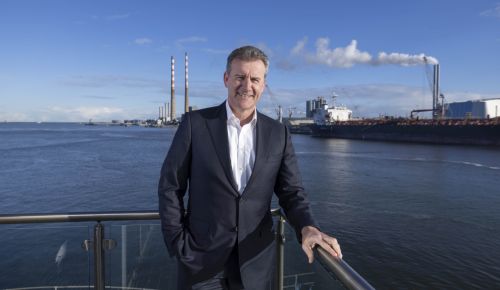Feature, Freight News, Sea
Dublin Port unveils plans to build Ireland’s largest container terminal
[ March 21, 2023 // Chris Lewis ]Dublin Port Company has started formal public consultation on the 3FM Project, the third and final Masterplan project to bring the gateway to its ultimate and final capacity by 2040 and will include the country’s largest container terminal .
The 3FM project is focused on Dublin Port lands on the Poolbeg Peninsula, on the south side of the bay and will deliver 20% of the capacity required by 2040. The Poolbeg peninsula already houses the greatest cluster of major utility operations in Ireland, with the largest wastewater works, the biggest waste-to-energy plant as well as power stations and part of the National Oil Reserve.
The 3FM project follows on from the first two Masterplan phases focused on the Port lands north of the bay – Alexandra Basin Redevelopment which is nearing completion and MP2 which has recently commenced construction. All three are pillars of Dublin Port Company’s highly strategic approach to maximising Port capacity which has been underway since 2010.
Public consultation is open until Friday, April 28. It follows initial conversations in 2021 with key stakeholders and also a first round of public engagement in November 2021 with feedback from this leading to changes to the initial plans. Since then, Dublin Port Company has prepared detailed
The project encompasses development of the largest container terminal in Ireland in front of the ESB’s Poolbeg Power Station. It will have 650 metres of new deeper water berths at the east of the port and comprise a 9.1 hectare area for exports at the waterside and a 5.9 hectare yard on the southern side of the Poolbeg peninsula for imports. It will have a total capacity of 353,000 units (600,000 TEU) annually – more than twice the number of containers handled in all other ports in the country last year.
The relocation of container traffic to the east of the Port will allow the construction of a major new ro-ro terminal just north of the Sean Moore Roundabout. This 12.6 hectare site will cater for the increasing volumes of traffic coming directly from Europe post-Brexit.
The project also includes a new 2.2km Southern Port Access Road to link the north and south port areas, and will include a 190m bridge, with a 45m lifting section to the east of the Tom Clarke Bridge. This will take heavy goods traffic off local roads by providing a dedicated route for port traffic as well as other heavy goods traffic on the Poolbeg Peninsula.
A new 325 metre ship turning circle in front of Pigeon House Harbour has been the subject of extensive simulation modelling and will allow safe and efficient turning of 240m long ferries – the largest class of vessels.
Dublin Port is the facilitator of economic growth in Ireland and the Masterplan is based on maximising Dublin Port’s capacity up to 2040. Dublin Port Company has previously highlighted that new port facilities will be needed elsewhere on the east coast to cater for increased port demand after that point. It says that without 3FM, Dublin Port would reach its capacity much earlier – perhaps by 2030, prompting the risk of a national port capacity shortage.
It is expected that a planning application for 3FM will be made to An Bord Pleanála in summer 2023 and based on a start date in 2026, the target completion date for the overall project is 2039.
Dublin Port chief executive Barry O’Connell (pictured) said: “Growth in volumes has been driven by a vibrant economy which has resulted in an increase in household consumption but also a hugely successful export sector. Exports now account for 40% of all movements through the port with at least some of the 60% of imports also comprising of raw materials later to be exported.
“With the value of exports up to 3.5 times that of imports it is clear to see how important the export sector is to the economy and indeed, how successful the State’s FDI strategy has been. Dublin Port, whilst having no direct influence on demand, has a critical role to play in facilitating this economic growth which is why the 3FM project is of critical importance as we look to a future of continued economic prosperity.
“Dublin Port will need to maximise capacity within its existing footprint for an annual throughput of 3.1 million trailers and containers by 2040. The 3FM project will deliver 20% of this capacity through the largest Lo-Lo terminal in Ireland – 353,000 containers per annum and a new Ro-Ro freight terminal – 252,000 freight trailers per annum.
“Dublin Port Company takes a generational approach to development at the Port – large infrastructure projects take up to 20 years from inception to completion. We know what we have to deliver on to enable Ireland’s growth up to 2040 and beyond and our expert team has been actively engaged in delivering the Masterplan for more than 10 years now. The ABR project is coming close to completion and we are pleased to have recently commenced the MP2 project on our northern lands.
“The Masterplan would be unable to progress without the support of all of our stakeholders and the early conversations in 2021 on 3FM, particularly with the statutory agencies, the major utilities already in Poolbeg and our local communities were extremely important in shaping our plans to this stage. We look forward to even greater engagement in the weeks ahead.”

Tags: Dublin Port Company











